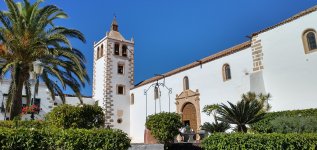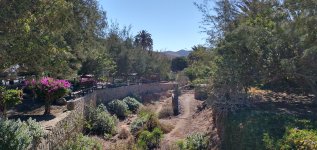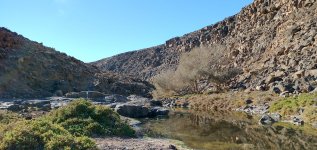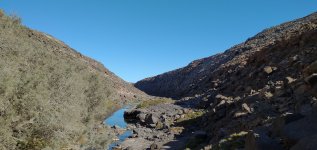
31 December. Fuerteventura (Barranco de Rio Cabras & Betancuria)
Superb day with good birding and a surprising abundance of butterflies. In tee-shirt and shorts, a chilly pre-dawn ride on the motorbike, but the result was worth it - as the sun began to rise, I was on the rocky lip of Barranco de Rio Cabras, the famed site of a long-standing Dwarf Bittern a couple of years earlier. Now long gone, the site is nevertheless impressive - to the west, still at roost, no less than 18 Egyptian Vultures adorned pylons, one out-of-place White Stork trying to merge in with them. A half dozen Common Buzzards completed the picture, along with a couple of Common Kestrels. On the gravel plains, Mediterranean Short-toed Larks and Trumpeter Finches, one Great Grey Shrike sentinel on an old post, plus a continual swirl of gulls (mostly Yellow-legged, some Lesser Black-backed) overhead on their way to a nearby rubbish tip. In the actual barranco, a trickle of water feeding a series of small pools made for very pleasant birding - heading the cast, several pairs of very confiding Fuerteventura Stonechats, very nice birds. Also Ruddy Shelducks, a scatter of waders (Little Ringed Plovers, Green Sandpipers, Common Redshank and Black-winged Stilts) and a few other bits and bobs, including my first Cattle Egrets of the trip.
As the day warmed up however, I was eager to move on. With the main focus of this day planned for butterflies, I headed to the Betancuria area with two main targets in mind - the endemic Fuerteventura Green-striped White and African Monarch (Plain Tiger). Being mid-winter and seemingly an exceptionally arid season, I had no real idea how easy these would be, but the day turned out far more productive than I expected, a grand total of ten butterfly species seen. First port of call was a hilltop mirador at Morro de la Cruz to try my luck for Fuerteventura Green-striped White - all a bit windswept on arrival, the sparce stunted native vegetation not immediately looking full of life. Barbary Ground Squirrels scurrying around, a couple of Berthelot's Pipits too, but no initial sign of any butterflies. However, on the sheltered lea of the slope, there I found butterflies - prize number one, Fuerteventura Green-striped White! At least 15 hurtling around the slopes, all were highly mobile and rarely settled for more than a few seconds, photography was a challenge indeed. Among them, prize number two - an unexpected bonus, two Greenish Black-tips, a butterfly predominantly restricted to North Africa and the Middle East. Kind enough to land on occasion, these gave me just enough time to scramble across the rocks and loose gravel to get a photo or two. One other species of butterfly also present, my first Painted Ladies of the trip.
With success on my first target, I then headed to historic village of Betancuria itself. This was to be one of the true highlights of Fuerteventura - not only a very beautiful village in its own right, but also boasting an amazing array of butterflies, absolutely not what I was expecting. The entire village is full of flowers and these themselves attracted a few butterflies, especially Red Admirals and Painted Ladies, but of more note was a dry stream bed that passed through the village - this was splendid, an absolute minimum of 35 African Monarchs sailing up and down the gully, settling in the warm sun and generally resulting in a very nice spectacle. With them, more Painted Ladies and Red Admirals, many Small Whites, three Clouded Yellows, at least five Geranium Bronzes and a couple of African Grass Blues. Adding to the variety, also one Hummingbird Hawk Moth and one Barbary Spurge Hawk Moth.
After quite a while here, I eventually decided to return to the coast, briefly calling in Fuerteventura Golf - greens coated in about 140 Ruddy Shelducks, a variety of birds on a couple of ornamental pools, including my only Wigeon of the trip, and, rounding off the day very nicely, three Monarchs drifting around clubhouse flowers. Never a bad day to see both Monarchs and African Monarchs!
After dark, decided to add a chill factor by riding the motorbike out to the Toto area for a first failed attempt to find the island's Barn Owl. Walked an hour or so with a spotlight, no luck. Thought I heard a distant one calling, it turned out to be an old windmill cranking in the wind!
Superb day with good birding and a surprising abundance of butterflies. In tee-shirt and shorts, a chilly pre-dawn ride on the motorbike, but the result was worth it - as the sun began to rise, I was on the rocky lip of Barranco de Rio Cabras, the famed site of a long-standing Dwarf Bittern a couple of years earlier. Now long gone, the site is nevertheless impressive - to the west, still at roost, no less than 18 Egyptian Vultures adorned pylons, one out-of-place White Stork trying to merge in with them. A half dozen Common Buzzards completed the picture, along with a couple of Common Kestrels. On the gravel plains, Mediterranean Short-toed Larks and Trumpeter Finches, one Great Grey Shrike sentinel on an old post, plus a continual swirl of gulls (mostly Yellow-legged, some Lesser Black-backed) overhead on their way to a nearby rubbish tip. In the actual barranco, a trickle of water feeding a series of small pools made for very pleasant birding - heading the cast, several pairs of very confiding Fuerteventura Stonechats, very nice birds. Also Ruddy Shelducks, a scatter of waders (Little Ringed Plovers, Green Sandpipers, Common Redshank and Black-winged Stilts) and a few other bits and bobs, including my first Cattle Egrets of the trip.
As the day warmed up however, I was eager to move on. With the main focus of this day planned for butterflies, I headed to the Betancuria area with two main targets in mind - the endemic Fuerteventura Green-striped White and African Monarch (Plain Tiger). Being mid-winter and seemingly an exceptionally arid season, I had no real idea how easy these would be, but the day turned out far more productive than I expected, a grand total of ten butterfly species seen. First port of call was a hilltop mirador at Morro de la Cruz to try my luck for Fuerteventura Green-striped White - all a bit windswept on arrival, the sparce stunted native vegetation not immediately looking full of life. Barbary Ground Squirrels scurrying around, a couple of Berthelot's Pipits too, but no initial sign of any butterflies. However, on the sheltered lea of the slope, there I found butterflies - prize number one, Fuerteventura Green-striped White! At least 15 hurtling around the slopes, all were highly mobile and rarely settled for more than a few seconds, photography was a challenge indeed. Among them, prize number two - an unexpected bonus, two Greenish Black-tips, a butterfly predominantly restricted to North Africa and the Middle East. Kind enough to land on occasion, these gave me just enough time to scramble across the rocks and loose gravel to get a photo or two. One other species of butterfly also present, my first Painted Ladies of the trip.
With success on my first target, I then headed to historic village of Betancuria itself. This was to be one of the true highlights of Fuerteventura - not only a very beautiful village in its own right, but also boasting an amazing array of butterflies, absolutely not what I was expecting. The entire village is full of flowers and these themselves attracted a few butterflies, especially Red Admirals and Painted Ladies, but of more note was a dry stream bed that passed through the village - this was splendid, an absolute minimum of 35 African Monarchs sailing up and down the gully, settling in the warm sun and generally resulting in a very nice spectacle. With them, more Painted Ladies and Red Admirals, many Small Whites, three Clouded Yellows, at least five Geranium Bronzes and a couple of African Grass Blues. Adding to the variety, also one Hummingbird Hawk Moth and one Barbary Spurge Hawk Moth.
After quite a while here, I eventually decided to return to the coast, briefly calling in Fuerteventura Golf - greens coated in about 140 Ruddy Shelducks, a variety of birds on a couple of ornamental pools, including my only Wigeon of the trip, and, rounding off the day very nicely, three Monarchs drifting around clubhouse flowers. Never a bad day to see both Monarchs and African Monarchs!
After dark, decided to add a chill factor by riding the motorbike out to the Toto area for a first failed attempt to find the island's Barn Owl. Walked an hour or so with a spotlight, no luck. Thought I heard a distant one calling, it turned out to be an old windmill cranking in the wind!
Last edited:








